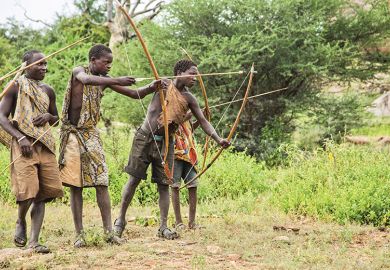In his introduction to the first edition of this collection of photographs of tribals in various parts of India, published ten years ago, the photographer Sunil Janah perceptively delineated his approach: "I went to the tribal villages because I came to love these people, and felt happy and relaxed among them. I adored the simplicity of 'primitive' societies. I loved the exciting visual stimulus of the costumes and the natural beauty of the people, which was such a joy to photograph. I lived among them as an untrained observer, having none of the technical qualifications of an anthropologist. I have not collected statistics or folklore or samples of their crafts. Nor have I recorded their music or measured their skulls. It is painful to find them swallowed up and assimilated by a narrow, rather repellent and over-zealous form of Indian nationalism, unable to fulfil Nehru's ideal of 'unity in diversity'."
Certainly, The Tribals of India , despite its publisher, is in no sense an academic work: it covers only a small proportion of India's tribals (chiefly in West Bengal and Orissa, northeastern India and Rajasthan) and contains only a handful of references to professional anthropologists, and no bibliography, footnotes or index. On the other hand, it is hardly a book for the coffee table: all the photographs are in black and white (if printed better than in the first edition), glamorous angles and lighting are eschewed, the design is sober and Janah's text is modest and understated.
Perhaps it is best described as a sort of visual journal of the author's travels, between 1943 and 1972, through a fast-vanishing tribal world.
Indeed, the text is based to a great extent on Bengali magazine articles of the 1960s derived from Janah's diaries, and he often describes, with considerable charm, his personal reactions to the people he met and the challenges he faced to reach and live in what were then remote areas.
The majority of the photographs are of individuals and groups of people, either as portraits or while involved in their daily activities, including festivals and ceremonies. A significant number of valuable images have been added in the new edition. They fully express Janah's affection for his subjects - especially young half-clothed women. The preponderance and prominence of bare breasts got him into trouble with Indian puritans from the beginning, and the eroticism is still a source of mild controversy. But as Janah remarks in a slightly defensive preface commenting on the Indian reaction to the first edition: "A young woman's body is beautiful and the appeal is largely sensual - that is how nature meant it to be... I do not know whether I should feel flattered or denigrated if the photographs I had taken of these simple primitive women without any make-up or lighting aids are considered 'seductive and titillating' by one reviewer."
Such charges of "exploitation" against Janah - who has made little money out of his work - are absurd and typically philistine. But does he in this book to some extent betray his talent as an artist? His other non-tribal photographs prove that he is a major Indian photojournalist, notably of the Bengal famine of 1943 and India's freedom movement, whereas his tribal photographs are neither entirely satisfactory as anthropological documentation (at least as presented in this small selection), nor are they as imaginatively composed and spontaneous as expected in portrait photography.
Nevertheless, in a field that is not crowded with serious photographic books, The Tribals of India is delightful and often thought provoking. All libraries specialising in Indian culture or anthropology should possess it.
Andrew Robinson is literary editor, The THES .
The Tribals of India: Through the Lens of Sunil Janah
Author - Sunil Janah
Publisher - Oxford University Press
Pages - 197
Price - £80.00
ISBN - 0 19 5661 3
Register to continue
Why register?
- Registration is free and only takes a moment
- Once registered, you can read 3 articles a month
- Sign up for our newsletter
Subscribe
Or subscribe for unlimited access to:
- Unlimited access to news, views, insights & reviews
- Digital editions
- Digital access to THE’s university and college rankings analysis
Already registered or a current subscriber?



